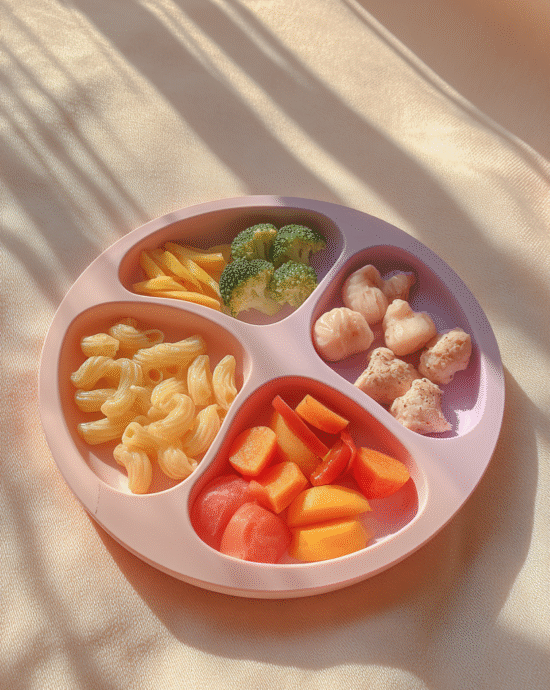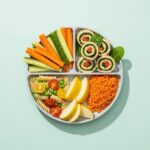introduction
Remember those blissful days of leisurely meals, savoring every bite and enjoying the quiet? Now, you’re navigating the whirlwind of toddlerhood, where mealtime is often a chaotic mix of demands, food flung across the room, and the dreaded “I don’t like it!” declarations. You’re exhausted, time is precious, and the thought of preparing a nutritious meal feels like climbing Mount Everest. You’re not alone. We’ve all been there, staring blankly into the refrigerator, wondering how to conjure up something healthy and appealing in the few precious minutes you have.
But what if I told you that you can conquer the toddler mealtime chaos? What if you could whip up delicious, nutritious meals in just 10 minutes, leaving you with more time for cuddles, playtime, and maybe even a few moments of peace?
This guide is your lifeline. We’re going to ditch the mealtime stress and embrace the power of quick, easy, and toddler-approved recipes. Get ready to reclaim your sanity and nourish your little>Why Fast Toddler Meals Are Essential for Busy Moms
Let’s be honest: time is the most valuable commodity for parents of toddlers. Between diaper changes, tantrums, playtime, and everything else, finding the time to prepare elaborate meals can feel impossible. Here’s why fast toddler meals are absolutely essential:
- •Saves Time & Reduces Stress: The obvious benefit! Quick meals free up precious time for other tasks or, even better, for self-care. Less time in the kitchen means less stress and more opportunities to connect with your child.
- •Prevents Hangry Meltdowns: Toddlers have small stomachs and need to eat frequently. Having quick meal options readily available prevents those dreaded “hangry” meltdowns that can derail your entire day.
- •Encourages Healthy Eating Habits: When meals are quick and easy, you’re more likely to offer nutritious options instead of resorting to processed snacks or takeout. This sets the foundation for healthy eating habits that will last a lifetime.
- •Reduces Food Waste: Planning and preparing smaller, quicker meals can help minimize food waste. You’re less likely to over-prepare and throw away leftovers if you’re focusing on simple, manageable portions.
- •Allows for Flexibility: Life with a toddler is unpredictable. Quick meals allow you to adapt to changing schedules and unexpected events without sacrificing nutrition.
Nutrition Guidance for Toddlers: Fueling Growth and Development
While speed is important, nutrition is paramount. Toddlers need a balanced diet to support their rapid growth and development. Here’s a quick overview of essential nutrients:
- •Protein: Essential for building and repairing tissues. Good sources include lean meats, poultry, fish, eggs, beans, lentils, and tofu.
- •Carbohydrates: Provide energy for active toddlers. Choose complex carbohydrates like whole grains, fruits, and vegetables over refined sugars.
- •Healthy Fats: Important for brain development and overall health. Include sources like avocado, nuts, seeds, and olive oil.
- •Vitamins & Minerals: Crucial for various bodily functions. Offer a variety of fruits and vegetables to ensure your toddler gets a wide range of vitamins and minerals. Consider a multivitamin if you have concerns about their intake (consult your pediatrician).
- •Fiber: Promotes healthy digestion. Good sources include whole grains, fruits, vegetables, and beans.
- •Calcium: Essential for strong bones and teeth. Dairy products, fortified plant-based milk, and leafy green vegetables are good sources.
- •Iron: Important for healthy blood. Lean meats, fortified cereals, and beans are good sources.
Portion Sizes: Toddler portions are much smaller than adult portions. A general guideline is to offer 1-2 tablespoons of each food group per year of age. So, a 2-year-old might eat 2-4 tablespoons of each food group. Don’t be afraid to let your toddler guide you – offer more if they’re still hungry, but don’t force them to eat more than they want.
Important Note: Always consult with your pediatrician or a registered dietitian for personalized nutrition advice for your toddler.
8 Delicious & Easy 10-Minute Toddler Meal Recipes
These recipes are designed to be quick, easy, and toddler-approved. Feel free to adapt them to your child’s preferences and dietary needs.
1. Cheesy Scrambled Eggs with Veggie Power:
- •Ingredients: 2 eggs, 1 tbsp milk or water, 1/4 cup shredded cheese (cheddar, mozzarella, or a blend), 1/4 cup chopped cooked vegetables (broccoli, spinach, carrots), salt and pepper to taste.
- •Instructions:
- •Why Toddlers Love It: Soft, cheesy, and easily customizable with their favorite veggies.
1. Whisk eggs with milk/water, salt, and pepper. 2. Melt a small amount of butter or oil in a non-stick skillet over medium heat. 3. Pour in the egg mixture and cook, stirring occasionally, until almost set. 4. Stir in cheese and cooked vegetables. 5. Cook until cheese is melted and eggs are fully cooked. 6. Serve immediately.
2. Peanut Butter (or Sunflower Seed Butter) & Banana Quesadilla:
- •Ingredients: 1 whole wheat tortilla, 1-2 tbsp peanut butter (or sunflower seed butter for allergies), 1/2 banana, sliced.
- •Instructions:
1. Spread peanut butter (or sunflower seed butter) evenly over>•Why Toddlers Love It: Sweet, nutty, and easy to hold.
3. Avocado Toast with Everything Bagel Seasoning:
- •Ingredients: 1 slice whole wheat toast, 1/4 avocado, mashed, a sprinkle of everything bagel seasoning.
- •Instructions:
- •Why Toddlers Love It: Creamy, flavorful, and packed with healthy fats.
1. Toast the bread. 2. Spread mashed avocado evenly over the toast. 3. Sprinkle with everything bagel seasoning. 4. Cut into strips or squares for easy handling.
4. Yogurt Parfait with Berries & Granola:
- •Ingredients: 1/2 cup plain Greek yogurt (or dairy-free alternative), 1/4 cup mixed berries (fresh or frozen), 1-2 tbsp granola.
- •Instructions:
- •Why Toddlers Love It: Sweet, crunchy, and packed with probiotics.
1. Layer yogurt, berries, and granola in a small bowl or cup. 2. Serve immediately.
5. Hummus & Veggie Wraps:
- •Ingredients: 1 whole wheat tortilla, 2-3 tbsp hummus, 1/4 cup chopped vegetables (cucumber, bell peppers, carrots).
- •Instructions:
- •Why Toddlers Love It: Flavorful, colorful, and easy to eat.
1. Spread hummus evenly over the tortilla. 2. Sprinkle with chopped vegetables. 3. Roll up the tortilla tightly. 4. Cut into bite-sized pieces.
6. Mini Chicken & Veggie Skewers:
- •Ingredients: Cooked chicken breast, cut into cubes; cherry tomatoes, cucumber chunks, bell pepper chunks.
- •Instructions:
1. Thread chicken and veggies>•Why Toddlers Love It: Fun to eat, colorful, and packed with protein and vegetables.
7. Quick Pasta with Pesto & Peas:
- •Ingredients: Cooked pasta (small shapes like ditalini or shells), 2 tbsp pesto (store-bought or homemade), 1/4 cup frozen peas (thawed).
- •Instructions:
- •Why Toddlers Love It: Flavorful, easy to eat, and packed with nutrients.
1. Toss cooked pasta with pesto and thawed peas. 2. Serve immediately.
8. Cottage Cheese with Fruit:
- •Ingredients: 1/2 cup cottage cheese, 1/4 cup chopped fruit (peaches, melon, berries).
- •Instructions:
- •Why Toddlers Love It: Creamy, sweet, and packed with protein and calcium.
1. Combine cottage cheese and fruit in a bowl. 2. Serve immediately.
9. Black Bean and Corn Salsa with Tortilla Chips:
- •Ingredients: 1/2 can black beans (rinsed and drained), 1/2 cup frozen corn (thawed), 1/4 cup diced red bell pepper, 1 tablespoon lime juice, a pinch of cumin, whole grain tortilla chips.
- •Instructions:
- •Why Toddlers Love It: Flavorful, colorful, and a fun way to eat beans and veggies.
1. Combine all ingredients (except tortilla chips) in a bowl and mix well. 2. Serve with whole grain tortilla chips for dipping.
10. Sweet Potato Fries (Microwave Version):
- •Ingredients: 1 small sweet potato, peeled and cut into fries, 1 teaspoon olive oil, a pinch of cinnamon.
- •Instructions:
- •Why Toddlers Love It: Sweet, soft, and a healthy alternative to traditional fries.
1. Toss sweet potato fries with olive oil and cinnamon. 2. Arrange fries in a single layer on a microwave-safe plate. 3. Microwave on high for 3-5 minutes, or until tender. (Cooking time may vary depending on your microwave.) 4. Let cool slightly before serving.
Tips to Store Leftovers Safely
- •Cool Quickly: Cool leftovers quickly to prevent bacterial growth. Divide food into smaller containers to speed up the cooling process.
- •Refrigerate Promptly: Refrigerate leftovers within 2 hours of cooking.
- •Use Airtight Containers: Store leftovers in airtight containers to prevent them from drying out and absorbing odors.
- •Label & Date: Label containers with the date to keep track of how long the food has been stored.
- •Reheat Thoroughly: Reheat leftovers thoroughly to an internal temperature of 165°F (74°C).
- •Storage Times: Generally, cooked meat, poultry, fish, and eggs can be stored in the refrigerator for 3-4 days. Cooked vegetables and grains can be stored for 3-5 days.
- •When in Doubt, Throw it Out: If you’re unsure about the safety of leftovers, it’s always best to err on the side of caution and discard them.
Weekly Meal Plan (Sample)
This is just a sample meal plan to give you some ideas. Adjust it to your toddler’s preferences and dietary needs.
Monday:
- •Breakfast: Yogurt Parfait with Berries & Granola
- •Lunch: Hummus & Veggie Wrap
- •Dinner: Quick Pasta with Pesto & Peas
Tuesday:
- •Breakfast: Cheesy Scrambled Eggs with Veggie Power
- •Lunch: Avocado Toast with Everything Bagel Seasoning
- •Dinner: Mini Chicken & Veggie Skewers
Wednesday:
- •Breakfast: Peanut Butter (or Sunflower Seed Butter) & Banana Quesadilla
- •Lunch: Cottage Cheese with Fruit
- •Dinner: Black Bean and Corn Salsa with Tortilla Chips
Thursday:
- •Breakfast: Yogurt Parfait with Berries & Granola
- •Lunch: Leftover Mini Chicken & Veggie Skewers
- •Dinner: Sweet Potato Fries (Microwave Version) with Chicken Nuggets (baked)
Friday:
- •Breakfast: Cheesy Scrambled Eggs with Veggie Power
- •Lunch: Hummus & Veggie Wrap
- •Dinner: Pizza Night (homemade or takeout – offer veggie toppings)
Saturday:
- •Breakfast: Pancakes (whole wheat) with Berries
- •Lunch: Leftover Pizza
- •Dinner: Burgers (lean beef or turkey) on Whole Wheat Buns with a side of steamed broccoli
Sunday:
- •Breakfast: Waffles (whole wheat) with Yogurt and Fruit
- •Lunch: Mac and Cheese (whole wheat pasta) with Peas
- •Dinner: Roasted Chicken with Roasted Vegetables (carrots, potatoes, sweet potatoes)
Frequently Asked Questions (FAQs)
- •My toddler is a picky eater. What can I do?
* Offer a variety of foods: Keep exposing your toddler to different flavors and textures, even if they initially reject them. * Don’t pressure them to eat: Pressuring can backfire and make them even more resistant. * Make mealtime fun: Use colorful plates, cut food into fun shapes, and involve them in meal preparation. * Offer dips: Dips like hummus, yogurt, or guacamole can make vegetables more appealing. * Sneak in vegetables: Puree vegetables into sauces or add them to baked goods. * Be patient and persistent: It can take multiple exposures for a child to accept a new food.
- •How can I make sure my toddler is getting enough iron?
- •My toddler has allergies. How can I adapt these recipes?
- •How can I get my toddler to drink more water?
* Offer iron-rich foods like lean meats, poultry, fish, beans, and fortified cereals. * Serve iron-rich foods with vitamin C-rich foods (like citrus fruits) to enhance iron absorption. * Avoid giving your toddler cow’s milk with meals, as it can interfere with iron absorption. * Talk to your pediatrician about iron supplementation if you have concerns.* Carefully read all food labels to avoid allergens. * Substitute ingredients as needed. For example, use sunflower seed butter instead of peanut butter, or dairy-free yogurt instead of cow’s milk yogurt. * Consult with your pediatrician or a registered dietitian for personalized allergy management advice.* Offer water throughout the day, especially between meals. * Make water more appealing by adding slices of fruit or cucumber. * Use fun cups or straws. * Avoid sugary drinks like juice and soda.
Internal & External Links Suggestions
Internal Links (within your website):
- •Link to other articles on your website about toddler nutrition, picky eating, or specific food allergies.
- •Link to product recommendations (if you have affiliate links) for toddler-friendly plates, utensils, or cookbooks.
- •Link to a page where parents can sign up for your email list for more recipes and tips.
External Links (to reputable sources):
- •CDC (Centers for Disease Control and Prevention): [https://www.cdc.gov/nutrition/index.html](https://www.cdc.gov/nutrition/index.html) (For general nutrition information)
- •American Academy of Pediatrics: [https://www.aap.org/](https://www.aap.org/) (For child health and development information)
- •USDA MyPlate: [https://www.myplate.gov/](https://www.myplate.gov/) (For dietary guidelines)
- •Registered Dietitian Websites: Link to websites of reputable registered dietitians specializing in pediatric nutrition.
- •Allergy Information: Link to websites like Food Allergy Research & Education (FARE) [https://www.foodallergy.org/](https://www.foodallergy.org/) if you discuss allergies.
By incorporating these easy 10-minute toddler meals into your routine, you can conquer the mealtime chaos and nourish your little one with delicious and healthy food. Remember, you’re doing a great job! Take a deep breath, embrace the simplicity, and enjoy the precious moments with your toddler. You’ve got this!









